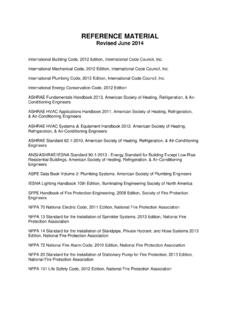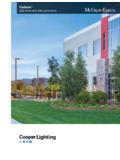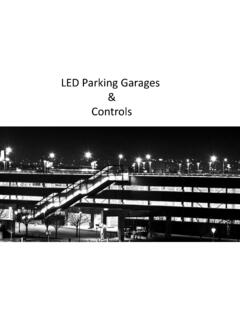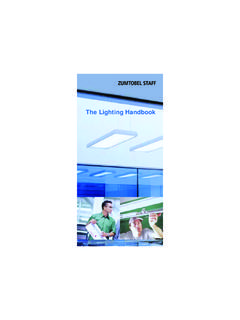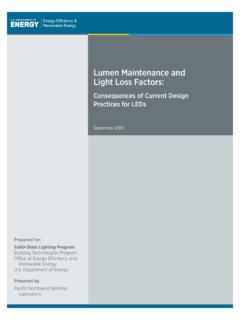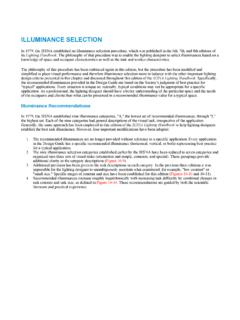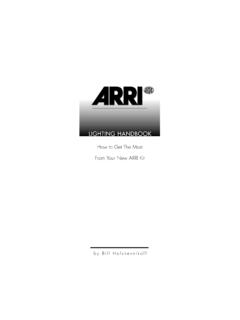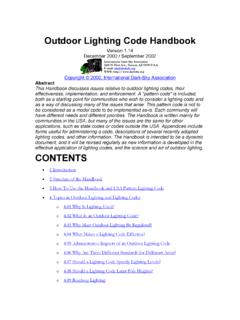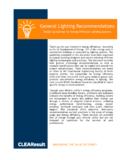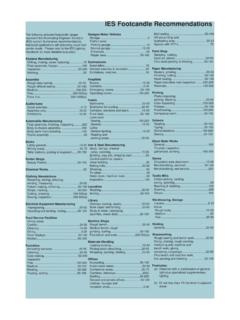Transcription of DESIGN STANDARDS Site Lighting Design Criteria Draft – …
1 DESIGN STANDARDS 26 Electrical site Lighting DESIGN Criteria Draft May 5, 2015 PART 1: GENERAL The purpose of this standard is to outline the Criteria to be used in designing new exterior Lighting on campus in order to create a safe and visually cohesive lighted environment in accordance with the Lehigh University Academic Lighting Master Plan Executive Summary and Residential Lighting Master Plan Executive Summary prepared by The Lighting Practice in 2014. References for Illuminance Recommendations A. The required illuminance levels included in this standard are from the following IESNA Guidelines: 1) IESNA Lighting handbook , 10th edition 2) IESNA Recommended Practice RP-33-99, Lighting for Exterior Environments 3) IESNA Recommended Practice RP-8-00, Roadway Lighting 4) IESNA G-1-03 Guideline for Security Lighting for People, Property, and Public Spaces 5) IESNA Recommended Practice RP-3-13, American National Standard Practice on Lighting for Educational Facilities References for Light Trespass and Uplight Control Recommendations A.
2 The required light trespass and uplight control Criteria included in this standard are based upon the following guidelines: 1) The Joint IDA (International Dark Sky) IES (Illuminating Engineering Society) Model Lighting Ordinance (MLO) with User s Guide, June 15, 2011 PART 2: PRODUCTS The following light fixtures are currently being used for new Lighting projects on campus. Contact Facilities Services and Campus Planning and Projects to confirm which of these lights should be used for new projects based upon the campus setting and to obtain additional DESIGN parameters, including existing electrical service information. A. LED Victorian Style Fixture: PennGlobe Newport 1000 Luminaire with Boston Fluted Post B.
3 LED Roadway and Parking Lot Fixture: Kim Lighting Altitude C. LED Residential Fixture: Beacon Lighting La Jolla PART 3: EXECUTION Residential Area Illuminance STANDARDS To be used around all existing and proposed residential buildings: A. Enhanced Security for Pedestrian Pathways: Average Maintained Horizontal Illuminance: FC measured at grade Maximum Contrast Ratio: 4:1 Average to Minimum Average Maintained Vertical Illuminance: FC measured at 6-feet above grade 1 DESIGN STANDARDS 26 Electrical site Lighting DESIGN Criteria Draft May 5, 2015 B. Canopied Primary Building Entries: Average Maintained Horizontal Illuminance: FC measured at grade Maximum Contrast Ratio: 2:1 Average to Minimum Average Maintained Vertical Illuminance: FC measured at 6-feet above grade C.
4 Non-Covered Primary Building Entries: Average Maintained Horizontal Illuminance: FC measured at grade Maximum Contrast Ratio: 2:1 Average to Minimum Average Maintained Vertical Illuminance: FC measured at 6-feet above grade D. Vehicular Drives: Average Maintained Horizontal Illuminance: FC measured at grade Maximum Contrast Ratio: 6:1 Average to Minimum E. Enhanced Security for Surface Parking Lots: Average Maintained Horizontal Illuminance: measured on the pavement Maximum Contrast Ratio: 4:1 Average to Minimum Average Maintained Vertical Illuminance: FC measured at 6-feet above grade Academic Area Illuminance STANDARDS To be used around all existing and proposed non-residential buildings: A.
5 Pedestrian Pathways: Average Maintained Horizontal Illuminance: FC measured at grade Maximum Contrast Ratio: 10:1 Maximum to Minimum B. Enhanced Security for Pedestrian Pathways: Average Maintained Horizontal Illuminance: FC measured at grade Maximum Contrast Ratio: 4:1 Average to Minimum Average Maintained Vertical Illuminance: FC measured at 6-feet above grade C. Canopied Primary Building Entries: Average Maintained Horizontal Illuminance: FC measured at grade Maximum Contrast Ratio: 2:1 Average to Minimum Average Maintained Vertical Illuminance: FC measured at 6-feet above grade D. Non-Covered Primary Building Entries: Average Maintained Horizontal Illuminance: FC measured at grade Maximum Contrast Ratio: 2:1 Average to Minimum Average Maintained Vertical Illuminance: FC measured at 6-feet above grade E.
6 Vehicular Drives: Average Maintained Horizontal Illuminance: FC measured at grade Maximum Contrast Ratio: 6:1 Average to Minimum 2 DESIGN STANDARDS 26 Electrical site Lighting DESIGN Criteria Draft May 5, 2015 F. Parking Garage Parking Field: Minimum Horizontal Illuminance: FC measured at grade Average Maintained Horizontal Illuminance: FC measured at grade Maximum Contrast Ratio: 10:1 Maximum to Minimum Average Maintained Vertical Illuminance: FC measured at 6-feet above grade G. Parking Garage Vehicular Entry: Average Maintained Horizontal Illuminance: 50 FC daytime at grade for first 66 feet FC nighttime at grade Maximum Contrast Ratio: 10:1 Average to Minimum Average Maintained Vertical Illuminance: 25 FC daytime at 6-feet above grade FC nighttime at 6-feet above grade H.
7 Surface Parking Lots and Parking Garage Top Decks: Average Maintained Horizontal Illuminance: FC measured at grade Maximum Contrast Ratio: 20:1 Maximum to Minimum Minimum Vertical Illuminance: FC measured at 6-feet above grade I. Enhanced Security for Surface Parking Lots: Average Maintained Horizontal Illuminance: measured on the pavement Maximum Contrast Ratio: 4:1 Average to Minimum Average Maintained Vertical Illuminance: FC measured at 6-feet above grade Light Trespass and Uplight Control STANDARDS A. All luminaires shall minimize uplight and glare. Backlight shall also be controlled when a luminaire is installed adjacent to property not owned by Lehigh University.
8 The lumen output will be controlled, by default, by putting the following limits on Backlight, Uplight and Glare using the following Criteria : 1) Backlight, Uplight and Glare STANDARDS for all fraternities and sororities Lighting Zone 1 Ratings: Backlight: B3 Uplight: U1 Glare: G1 2) Backlight, Uplight and Glare STANDARDS for all other areas on campus Lighting Zone 2 Ratings Backlight: B4 Uplight: U2 Glare: G2 3 DESIGN STANDARDS 26 Electrical site Lighting DESIGN Criteria Draft May 5, 2015 B. Full cut-off sources should be used for building entries and perimeter Lighting . C. Fixtures at doorways should not exceed 10W. Building perimeter Lighting should not exceed 20W.
9 Wattage requirements may depend on actual application and illuminance requirements. D. The use of building and pole mounted floodlights for general area Lighting is prohibited. Light Sources and Color A. High color rendering LED sources with a color temperature of 4000 Kelvin and a minimum color rendering index (CRI) of 70 shall be used. B. These white light sources provide better color rendition of skin tones and material colors and easier identification of surroundings and people. White light sources above 4000K can impact the flight routes of migratory birds and the circadian rhythm in animals. LED light sources are preferred due to their long-life and low energy use.
10 4
